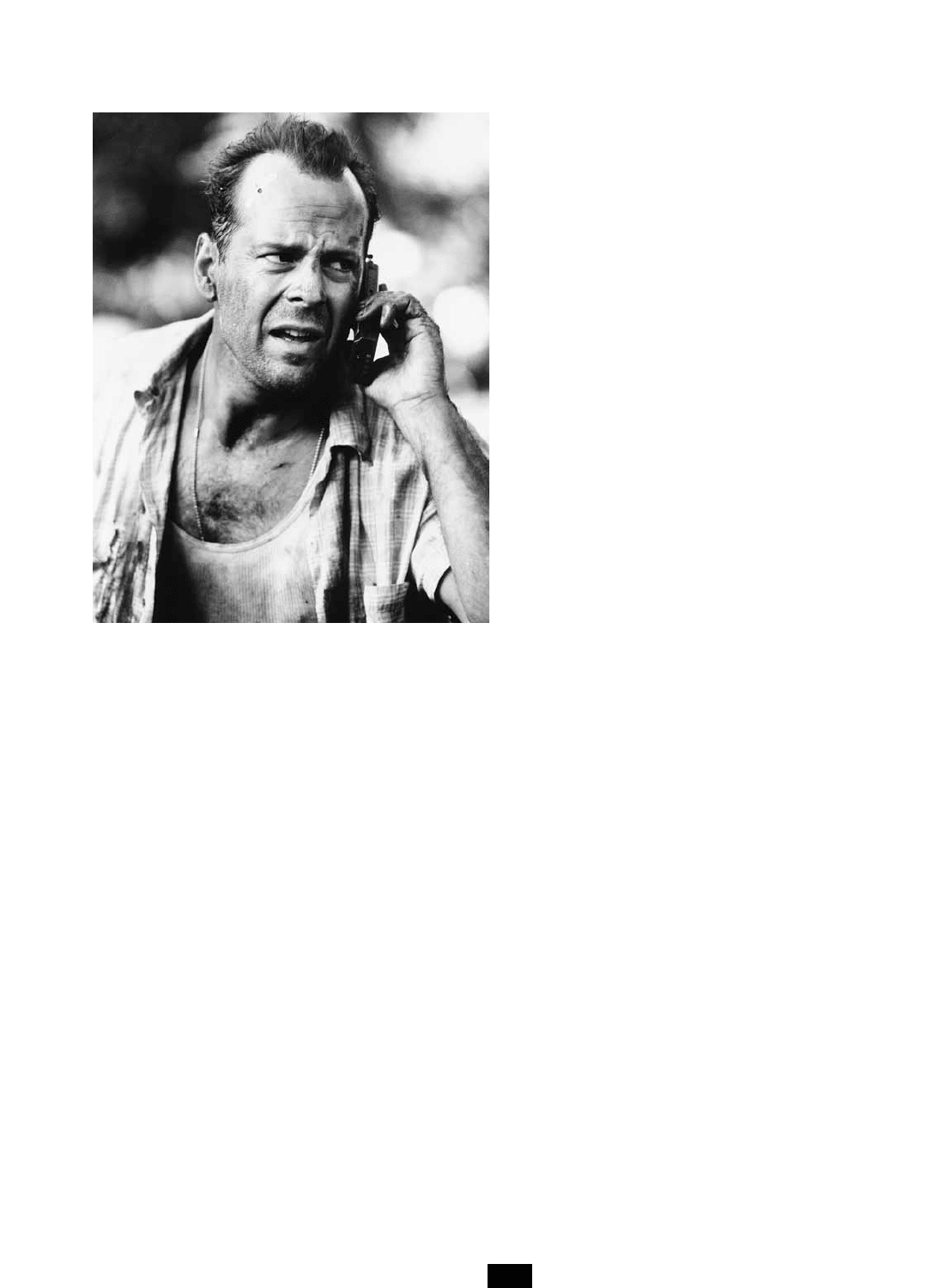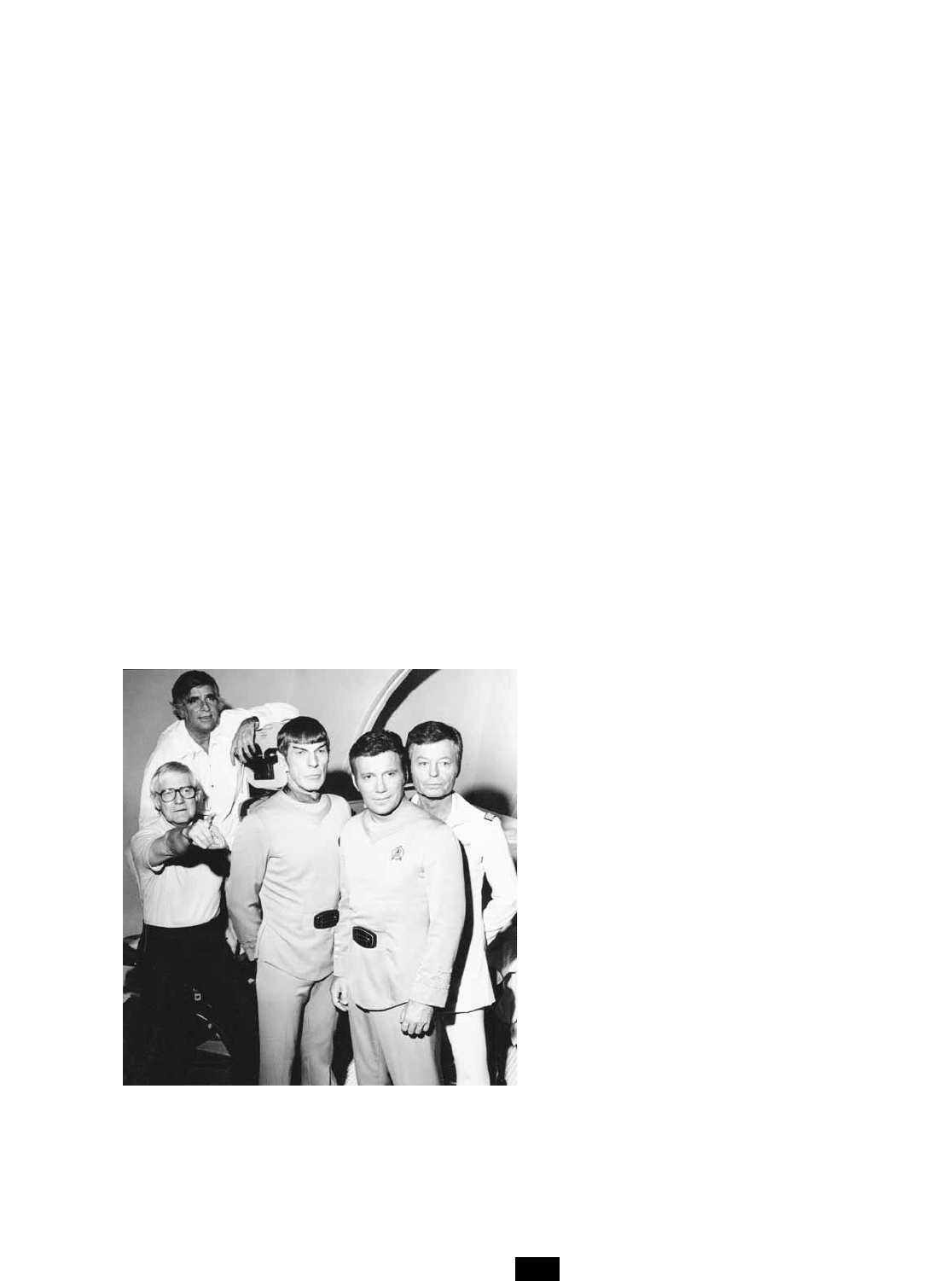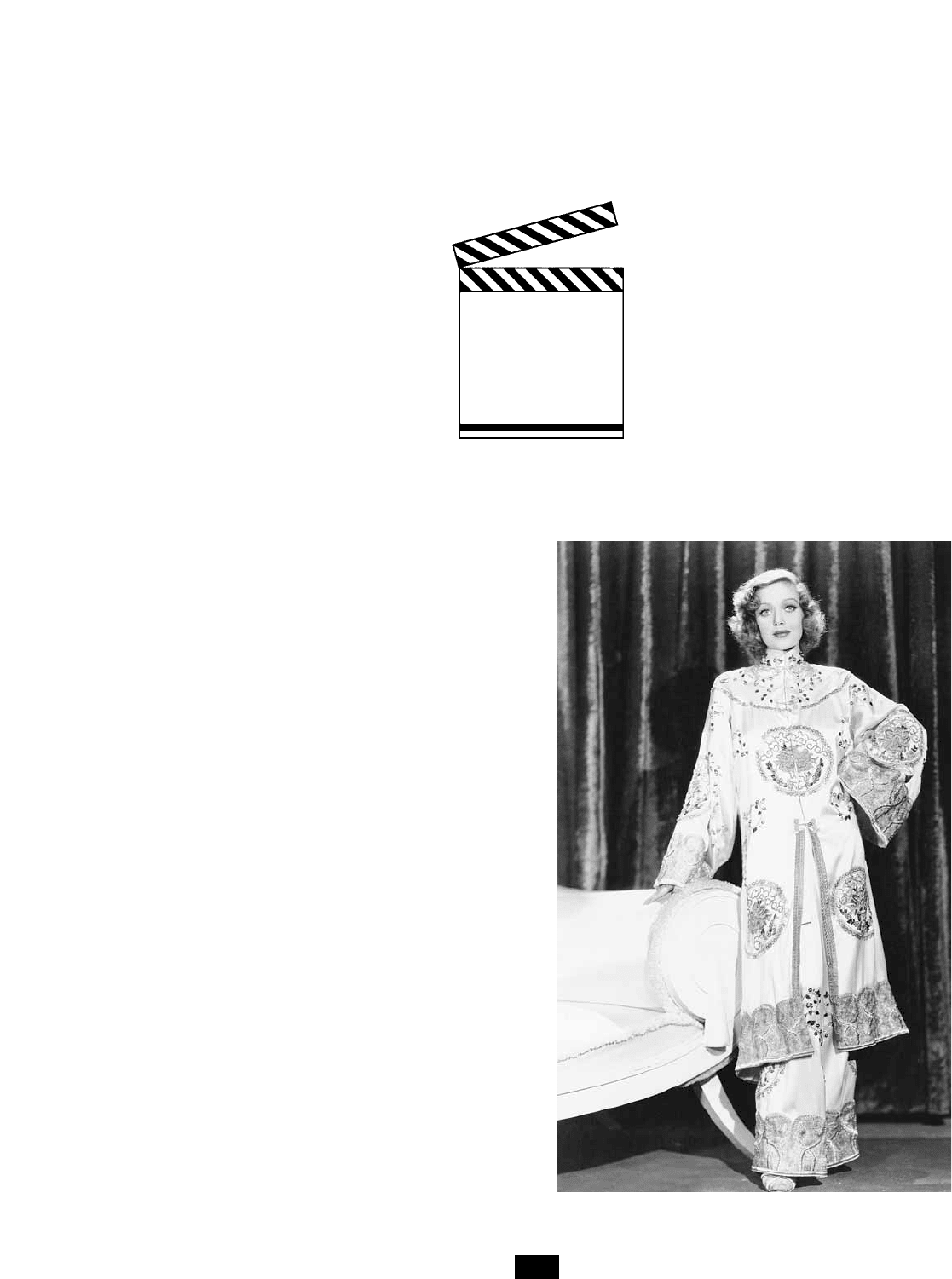Siegel S., Siegel B. The Encyclopedia Of Hollywood
Подождите немного. Документ загружается.


Bathgate, a prestigious picture adapted by Tom Stoppard
from the E. L. Doctorow novel.
Other prestigious projects included
ROBERT ALTMAN
’s The
Player (1992) and a memorable role in
QUENTIN TARANTINO
’s
Pulp Fiction (1994). Drawn to the offbeat, he starred in Luc
Besson’s The Fifth Element (1997), Terry Gilliam’s Twelve Mon-
keys (1995, a remake of Chris Marker’s La Jetée), and Last Man
Standing (1997, a remake of Akira Kurosawa’s Japanese classic,
Yojimbo). Willis also appeared in The Jackal (1997), Armageddon
(1998), the hit The Sixth Sense (1999), The Whole Nine Yards
(2000), Unbreakable (2000), and Tears of the Sun (2003).
Willis, Gordon (1931– ) A gifted cinematographer
who has rediscovered the beauty of black-and-white photog-
raphy under the direction of
WOODY ALLEN
. Willis, who
began his career in 1970, has consistently worked with Allen
since Annie Hall (1977), but even before their unique collab-
oration, the cinematographer had firmly established a dis-
tinctive atmospheric style in films such as Loving (1970),
Klute (1971), and, most notably, The Godfather (1972) and The
Godfather, Part II (1974).
Working with Woody Allen, however, Willis has received
his overdue recognition. In particular, his evocative black-
and-white photography for films such as Interiors (1978),
Manhattan (1979), Zelig (1983), for which he won an Oscar
nomination, and Broadway Danny Rose (1984) has highlighted
a nearly lost art. He was nominated for an Academy Award
for Best Cinematography for his work on The Godfather, Part
III (1990) and was featured in the documentary Visions of
Light: The Art of Cinematography (1992). He received the
Lifetime Achievement Award from the American Society of
Cinematographers, a fitting tribute to one of Hollywood’s
most gifted cinematographers.
Wise, Robert (1914– ) A former film editor turned
director and sometime producer who has quietly emerged as
a filmmaker of considerable stature. It is no coincidence that
Wise’s career overlaps with many of Hollywood’s finest
moments. He edited
ORSON WELLES
’s two classics, Citizen
Kane (1941) and The Magnificent Ambersons (1942), directed
three films in the highly praised
VAL LEWTON
series of hor-
ror movies in the early 1940s, directed several low-budget
genre films in the late 1940s and early 1950s that have
become cult classics, and then directed several of Holly-
wood’s most expensive musicals of the 1960s, including two
monster hits. In all, Wise’s pictures have garnered 67 Acad-
emy Award nominations and 19 Oscars. Wise himself has
been nominated seven times and has won four Oscars. He
was also the recipient of the academy’s Irving Thalberg
Award in 1967 and the Directors Guild prestigious
D
.
W
.
GRIFFITH
Award in 1988.
The son of a meat packer, Wise had hoped to become a
journalist but was unable to continue his studies during the
depression. Looking for work, he traveled to Hollywood,
where he got a job as a messenger in RKO’s film editing
department with the help of his older brother, David, then an
accountant with the studio. Soon he was fascinated by the
way movies were cut and patched together, and before long
he was given an opportunity to try his hand at the art. After
nine months, he was made an apprentice sound-effects editor
and later a music editor.
Wise received his first film credit for a 10-minute short
subject and eventually received a promotion to assistant edi-
tor, finally becoming a film editor in 1938. He edited such
films as Bachelor Mother (1939), The Hunchback of Notre Dame
(1939), The Story of Vernon and Irene Castle (1939), and The
Fallen Sparrow (1943). In addition to editing the previously
mentioned Welles films, he also directed the controversial
final scenes in The Magnificent Ambersons, much to the con-
sternation of Welles’s devotees.
After the Ambersons experience, Wise began to bombard
RKO executives with requests to direct. In 1943, he was edit-
ing Curse of the Cat People when its original director, far
behind schedule, was removed. Wise was given the job; the
movie became a hit in the Val Lewton cycle of horror films;
and Wise was established forevermore as a director.
During the next several years, he continued to direct low-
budget films, many of them horror and suspense movies such
as the highly regarded The Body Snatcher (1945) and Born to
Kill (1947). His big break came with Blood on the Moon (1948),
a significant critical and commercial success. He followed it
WISE, ROBERT
467
Bruce Willis in Die Hard with a Vengeance (1995) (PHOTO
COURTESY TWENTIETH CENTURY FOX)

with what some film buffs consider one the best boxing
movies ever made (and also one of very few movies that takes
place in real time), The Set-Up (1949). Not long after, in
1951, Wise made yet another cult favorite, the memorable
science-fiction film The Day the Earth Stood Still.
Wise’s films became less interesting during the rest of the
1950s, but he made a few solid hits, among them Executive
Suite (1954), Somebody Up There Likes Me (1956), Run Silent,
Run Deep (1958), and I Want to Live! (1958). It wasn’t until the
early 1960s, however, that Wise ascended the Hollywood lad-
der as a director of megabuck hits, producing and codirecting
(with Jerome Robbins) West Side Story (1961) and directing
and producing The Sound of Music (1965). Wise won double
Oscars for both films, garnering
ACADEMY AWARDS
for Best
Director and producer of those two Best Picture winners.
As one of the grand old men of Hollywood and one of the
few directors the studios would entrust with a big budget,
Wise continued to make expensive movies. Except for The
Sand Pebbles (1966), he had more misses than hits, making
such major bombs as Star! (1968) and The Hindenburg (1975).
Nonetheless, the old pro who had directed The Day the Earth
Stood Still was brought in to direct the first of what would
become a hit series of science fiction films, Star Trek—The
Motion Picture (1979).
Wise has been less active as a director in recent years, hav-
ing been elected president of the Academy of Motion Picture
Arts and Sciences in 1985. He did, however, finally return to
film directing in 1989 with the disappointing musical Rooftops.
women directors For all the glamour and beauty that is
Hollywood, men have dominated the movie industry for
most of its existence, but if in recent years it seems as if
women have been making inroads as writers, producers, and,
particularly, directors, female success in the motion picture
business doesn’t begin to touch the influence women had in
the industry during the silent era.
A great many women pioneered the movies alongside
men in the years before the formation of the studio system.
Alice Guy Blaché was the world’s first woman director,
beginning her work in France in 1896. In 1910, she became
the first woman to own her own studio in the United States,
the Solax Company. A number of other women would later
have their own studios and production companies, including
Lule Warrenton, Dorothy Davenport, and Lois Weber.
The women directors of the 1910s and 1920s weren’t
unusual, nor were they relegated to minor movie status.
According to Anthony Slide, in his book Early Women Direc-
tors, most film studios employed at least one female director,
and Universal Pictures actually had, at one time, nine women
in charge of their own productions.
A significant number of actresses became directors during
the silent era, usually starting their careers behind the cam-
era by directing themselves. Among the less well-remem-
bered actress/directors were Cleo Madison, Ruth
Stonehouse, Margery Wilson, Gene Gauntier, Kathlyn
Williams, and Lucille McVey. Among the more famous stars
who directed themselves were
LILLIAN GISH
, Alla Nazimova,
and Mabel Normand.
Women were also well represented in the ranks of sce-
nario writers. Many of these screenwriters became directors,
as well. For instance, Ida May Park, Ruth Ann Baldwin, and
Jeanie MacPherson were all scenario writers who became
directors. The most successful of all female screenwriters,
Frances Marion, who wrote a prodigious number of hit films,
including Stella Dallas (1925), The Champ (1931), Dinner at
Eight (1933), and Camille (1937), also directed and produced
several films. She did not, however, have the same success as
a director as she had as a screenwriter.
By the time of the talkie revolution, women were finding
it increasingly difficult to find work as directors. The only
woman who managed to make it into the 1930s as a director
at a major studio was Dorothy Arzner; she was Hollywood’s
only woman director at that time. Among her credits were
such films as Christopher Strong (1933) and Craig’s Wife (1936).
There was no other female director at a major studio in
Hollywood until actress Ida Lupino began to work behind
the camera in 1950 with Outrage, which she also coscripted.
She directed a handful of other motion pictures, leaving the
door open for other women to follow.
The flow of female film directors continued as a trickle
with Joan Micklin Silver’s much-admired movie Hester Street
(1975). Silver went on to direct the popular romantic comedy
Crossing Delancey (1988); the well-received and controversial
A Private Matter (1992), a film about abortion; and two other
films, one made for cable and one a disappointing teen flick.
Claudia Weill directed Girlfriends in 1978, but it was not until
1997 that she got to direct another film, Critical Choices, a film
about struggles at an abortion clinic.
WOMEN DIRECTORS
468
Director Robert Wise’s pictures have garnered numerous
Academy Award nominations and Oscars. Wise himself has
been nominated several times and has won several Oscars.
He is pictured here directing Star Trek—The Motion Picture
(1979)
(PHOTO © 1978 PARAMOUNT PICTURES CORPO-
RATION, COURTESY OF ROBERT WISE)

In the late 1970s, some actresses stepped behind the cam-
era. Anne Bancroft coscripted and directed Fatso (1979), and
Barbra Streisand began her directing career with Yentl (1983),
which she followed by the critically acclaimed and popular
The Prince of Tides (1991) and The Mirror Has Two Faces (1996).
Sondra Locke directed and starred in Ratboy (1986), which
was followed by Impulse (1990) and Trading Favors (1997).
Diane Keaton broke into directing in 1987 with Heaven,
which was followed by Wildflower (1991) and Unsung Heroes
(1995). Lee Grant directed two films, Tell Me a Riddle (1980)
and Staying Together (1989). The most successful of the
actress/directors has been
PENNY MARSHALL
of Laverne and
Shirley television fame. She began with the hugely popular Big
(1988), starring Tom Hanks, and has continued to make excel-
lent films such as Awakenings (1990), which won an Oscar
nomination for Best Picture; A League of Their Own (1992), a
film about women’s baseball; Renaissance Man (1994), a com-
edy with Danny DeVito; and The Preacher’s Wife (1996), with
DENZEL WASHINGTON
and Whitney Houston.
More significantly, nonactresses have recently been mak-
ing their mark in Hollywood as directors. Susan Seidelman
directed four films in the 1980s, among them the cult classic
Desperately Seeking Susan (1985), but her only film since then
is Tales of Erotica (1993). Joyce Chopra, Karen Arthur, and
Joan Tewksbury have also directed films in the 1990s. One of
the longest directing careers among women has been that of
Amy Heckerling, who got her start with the popular teen
flick Fast Times at Ridgemont High (1982) and has continued
to mine the teen and comic markets with such hits as Look
Who’s Talking (1989) and its 1990 sequel, as well as the
updated remake of Jane Austen’s Emma, titled Clueless (1995).
Two more prolific and outstanding female directors are
Martha Coolidge and Nora Ephron, who also writes scripts.
Coolidge’s hits include Rambling Rose (1991), Lost in Yonkers
(1993), and Out to Sea (1997). Ephron’s successes have been
even more impressive. She began with This Is My Life (1992),
which was followed by four films, including the two hugely
successful romantic comedies starring Meg Ryan and Tom
Hanks, Sleepless in Seattle (1993) and You’ve Got Mail (1998);
both received several Oscar nominations.
While there are still far fewer women behind movie cam-
eras than there are men, Hollywood is slowly working its way
back to the level of the silent era when women could be
found at all levels of filmmaking.
See also
ARZNER
,
DOROTHY
;
BLACHÉ
,
ALICE GUY
;
KEATON
,
DIANE
;
LUPINO
,
IDA
;
MARION
,
FRANCES
;
MAY
,
ELAINE
;
NORMAND
,
MABEL
;
STREISAND
,
BARBRA
.
women’s pictures Also sometimes known as tearjerkers
and “weepies,” these movies generally depict the romantic
(rather than the outright sexual) aspirations of leading char-
acters. Most often, the emotional rug is pulled from under
them by broken hearts, degradation, and illness. These films
always have a female protagonist and, unlike most serious
novels and stage works, are geared directly to the female
audience, often (at least in the past) with a decidedly senti-
mental point of view. Women’s pictures of the studio era are
notable for their great attention to clothing and hair styles, as
well as for their generally languid pace. Where films
designed for men often contain ample outdoor action scenes,
women’s pictures play themselves out on an internal land-
scape, marked by feelings, talk of commitments (or the lack
of them), betrayals, and so on, and as far as Hollywood is
concerned, they are also about big box office.
Films geared strictly to women became especially popu-
lar during the late 1910s and 1920s when going to the movies
became a solidly middle-class leisure activity. With his Victo-
rian sensibility,
D
.
W
.
GRIFFITH
made some of the most mem-
orable early women’s pictures. In Broken Blossoms (1919), for
instance, Lillian Gish falls in love with an Asian man (played
by Richard Barthelmess). Given the racial attitudes of the
time, it was an impossible love story, which made it a perfect
example of the genre’s developing formula. For decades to
come, any love affair that was doomed to failure had the
ingredients of a potential woman’s picture.
There have been any number of actresses who have
excelled in the genre, most notably
GRETA GARBO
, Janet
Gaynor, Irene Dunne,
VIVIEN LEIGH
, Margaret Sullavan,
BETTE DAVIS
,
JOAN CRAWFORD
, Greer Garson,
SUSAN HAY
-
WARD
,
SHIRLEY MACLAINE
, and many others. But when one
looks at the best of the women’s pictures, one sees the steady
work of a relative handful of directors. For example, it was
Clarence Brown who directed many of Greta Garbo’s most
romantic movies during the late 1920s and 1930s, and it was
Frank Borzage who made many of the greatest films of the
genre during those same years when he directed Seventh
Heaven (1927), Street Angel (1928), Bad Girl (1932), and History
Is Made at Night (1938). He was joined by
GEORGE CUKOR
who was well known for bringing out the best in female per-
formers and directed such fully realized women’s pictures as
Camille (1936), Gaslight (1944), and The Actress (1953). The last
director to genuinely specialize in the area (and then, only at
the end of his career), was
DOUGLAS SIRK
, who made such rich
soap operas as the remake of Magnificent Obsession (1954),
Written on the Wind (1957), and Tarnished Angels (1958).
The women’s picture thrived during the studio era, and
such films were often made by others besides the great mas-
ters of the genre. A good “schmaltzy” story was the key, and
both hack and accomplished directors contributed such clas-
sics as Back Street, which was so potent at the box office that
it was made three times, in 1932, 1941, and 1961. Waterloo
Bridge was another all-time great that was made three times,
in 1931, 1940, and in 1956 as Gaby. Leo McCarey made the
tearjerker Love Affair (1939) and decided to remake it himself
in 1957 as An Affair to Remember. Wuthering Heights (1939),
Random Harvest (1942), Letter from an Unknown Woman
(1948), Love Is a Many Splendored Thing (1955), and Splendor
in the Grass (1961) are a sampling of some of the genre’s best.
Perhaps the single most important woman’s picture from
an historical perspective was Dark Victory (1939). This
weepie starring Bette Davis was the first to have an essentially
innocent person die at the end. The commercial success of
Dark Victory opened the floodgates to a whole new era of
tearjerkers where life and death hang in the balance.
Women’s pictures went into decline once the studio era
ended and individual filmmakers, most of them men, began
to make movies independently. In addition, with the rise of
WOMEN’S PICTURES
469

the women’s movement, old-fashioned romance went some-
what out of style. Perhaps the last pure example of the genre
is Love Story (1970).
The modern women’s picture has become far more
sophisticated, but the basic elements of a female protagonist
and female concerns has not changed. Now, however, the
themes (in addition to romance and death) have been broad-
ened to include such social issues as career choice and rape.
Examples of the modern women’s picture are The Turning
Point (1977), Terms of Endearment (1983), The Accused (1988),
and Beaches (1989).
Because of changing attitudes toward sex and gender roles,
there have been relatively few “traditional” women’s films
since 1990. There is a kind of “unisex” quality about films,
except for the ultraviolent films men have traditionally liked.
The difference between the films still exists, however, as indi-
cated by the discussion of “women’s films” such as An Affair to
Remember (1957) and “men’s films” such as The Dirty Dozen
(1967) and in the film Sleepless in Seattle (1993). There are still
films that are more popular with women than with men.
Films dealing with the way women respond to each other
in the face of death include Marvin’s Room (1996) and One
True Thing (1998), both starring
MERYL STREEP
, who seems
to have an affinity for such roles. The “romance” films mostly
involved
MEG RYAN
and
JULIA ROBERTS
and included such
films as Sleepless in Seattle, You’ve Got Mail (1998), The Run-
away Bride (1999), and One Day in September (2000), the last
of which combines romance with death. A film about mature
romance was The Bridges of Madison County (1995), featuring
Meryl Streep and
CLINT EASTWOOD
. The most popular
romantic film of the 1990s was undoubtedly Titanic (1997), a
sentimental weepie that many adolescent girls bragged about
seeing more than a dozen times.
Of course, there is another side to romance—divorce—
and some films dealt with the problem seriously, but two
films approached the issue from a “women don’t get mad;
they get even” perspective. The First Wives Club (1996) fea-
tured the revenge exacted by Bette Midler,
DIANE KEATON
,
and
GOLDIE HAWN
; and Waiting to Exhale (1995) demon-
strated that black women were every bit as adept at taking
revenge as their white sisters.
Revenge was taken to new heights in Death and the
Maiden (1994) in which a woman (
SIGOURNEY WEAVER
)
avenges herself on the man whom she believes abused her 15
years before. The film was directed by
ROMAN POLANSKI
and
adapted from an Ariel Dorfman play. A similar film, also
adapted from a play, was Extremities (1986). The very fact
that these two plays were adapted to film indicates that their
makers believed there was an audience for them.
Other films that feature communities of women or mul-
tiple generations of women include Widows’ Peak (1994), a
film about a town run by women; Steel Magnolias (1989),
which focused on women in a beauty shop; Fried Green
Tomatoes (1991), a film about women gaining their inde-
pendence; Tea with Mussolini (1999), a film about women
“imprisoned” in Italy during World War II; and The Joy
Luck Club (1993), which traced the fates of Chinese-Ameri-
can women.
Two of the most critically acclaimed films of 2002 were
women’s films. The Hours was about three women in different
eras and asserted that independence is essential for women,
even if it means forsaking traditional spousal and child-rear-
ing duties. Far from Heaven explored the problems that beset
a 1950s suburban housewife who must deal not only with her
husband’s homosexuality but also with the bigotry of her
community when it discovers her association with an
African-American man.
See also
BORZAGE
,
FRANK
;
LE ROY
,
MERVYN
.
Wood, Natalie (1938–1981) She was among the rare
child actors who made the leap from moppet to adult movie
star, but she was an actress of contradictions. Though per-
ceived as a mediocre performer, she managed to garner three
Oscar nominations; though a great beauty, her acting lacked
a sensual fire; and despite her consistent popularity, she
never achieved superstar status and was often overshadowed
by her costars.
Born Natasha Gurdin to a Russian father and French
mother, she grew up speaking several languages and studied
dance (her mother had been a ballerina) at a very early age.
When she was four years old, Happy Land (1943) was being
filmed in her hometown of Rosita, California, and she landed
a tiny role in the movie. The director, Irving Pichel, was
impressed with her and cast her several years later when he
needed a child actress who could play the part of a German
refugee in Tomorrow Is Forever (1946). It was the start of the
actress’s career.
As a child star, Wood was no
MARGARET O
’
BRIEN
, but
she was both pretty and sincere. Young Natalie made her
mark in films such as Miracle on 34th Street (1947) and
Scudda-Hoo! Scudda-Hay! (1948). In the early 1950s she tried
television, starring in a series called Pride of the Family. She
did not succeed on the small screen and returned to the
movies, struggling through the awkward period of adoles-
cence. It wasn’t until she blossomed as a young adult and
costarred with
JAMES DEAN
in Rebel Without a Cause (1955)
that she emerged as a potential new star. Winning a Best
Supporting Actress Academy Award nomination for her per-
formance brought her increased visibility, though James
Dean was the focus of most people’s attention.
Full-fledged stardom did not come quickly. Just as she
was overwhelmed in Rebel Without a Cause by the acting of
James Dean and Sal Mineo, she passed through a succession
of 1950s films such as Marjorie Morningstar (1958) without
making a very great impression. Her films, though, were gen-
erally popular at the box office, and she was just 22 years old
as the 1960s began, a decade in which she gave the lion’s
share of her best and most memorable performances.
Her career finally took off when she starred opposite
WARREN BEATTY
in
ELIA KAZAN
’s production of Splendor in
the Grass (1961) and received an Oscar nomination for Best
Actress. To the surprise of many, she was then cast as Maria
in West Side Story (1961). Her childhood dance training came
in handy for the film, but her singing voice was dubbed by
Marni Nixon.
WOOD, NATALIE
470

Those two hit films were followed by a nearly unbroken
streak of box-office winners that lasted until the end of the
decade. She was at the height of her career, starring in Love
with the Proper Stranger (1963) with
STEVE MCQUEEN
and
winning her third and final Oscar nomination, Sex and the
Single Girl (1964) with
TONY CURTIS
, Inside Daisy Clover
(1966) with
ROBERT REDFORD
, This Property Is Condemned
(1966) with Redford again, and Bob & Carol & Ted & Alice
(1969) with Dyan Cannon, Elliott Gould, and Robert Culp.
The titles of most of her 1960s films were suggestive—
and often controversial—but both the movies and Natalie
Wood proved in the end to be rather tame.
Married twice to actor Robert Wagner, Ms. Wood
devoted most of the 1970s to home life. She made a few films
for TV and theatrical release, the most notable being the
underrated comedy with George Segal The Last Married Cou-
ple in America (1979). She nearly completed a big-budget
thriller called Brainstorm when she drowned in a mysterious
boating accident in 1981. Brainstorm was released posthu-
mously in 1983 with little fanfare.
See also
CHILD STARS
.
Woodward, Joanne (1930– ) An actress who began
her film career in sexy roles but who soon displayed her tal-
ent starring in character parts to which she brought depth of
perception. Since her film career began in 1955, Woodward
has either acted with or been directed by her longtime hus-
band, Paul Newman, in nearly half of all her motion pictures.
This was not a case of nepotism, however; Woodward had
already won an Oscar for her electric performance in The
Three Faces of Eve (1957) during Newman’s initial flush of
popularity in the mid- to late 1950s.
Born to a well-to-do family in Georgia, Woodward acted
in high school and college, as well as for a small community
theater, before making the trip to New York to study acting
at the Neighborhood Playhouse. Soon she began to appear in
live TV dramas, but had the first and most important break
of her career when she won an understudy role in the 1953
Broadway production of Picnic; the supporting-actor role in
the play was performed by Paul Newman. The two married
five years later in 1958.
Woodward made her movie debut in a starring role in
Count Three and Pray (1955). In the year that she and Newman
were wed, they starred together in two films, The Long Hot
Summer (1958) and Rally Round the Flag, Boys! (1958). Their
other acting collaborations include From the Terrace (1960),
Paris Blues (1961), A New Kind of Love (1963), Winning (1969),
WUSA (1970), and The Drowning Pool (1975). In most of the
later films, the couple was better than their material.
Woodward also starred in a number of films that were
directed by Newman: Rachel, Rachel (1968), for which she was
nominated for an Oscar, The Effect of Gamma Rays on Man-in-
the-Moon Marigolds (1972), a TV movie The Shadow Box
(1981), Harry and Son (1984), in which Newman also starred,
and The Glass Menagerie (1987). These films were largely of a
very high caliber, although none of them was a box-office
winner except Rachel, Rachel, but in every film in which New-
man directed her, Woodward received glowing notices for
her work.
During the last 50 years, Woodward has done splendid
work in solo efforts that have often been overlooked. Her abil-
ities as a character actress are best displayed in movies such as
A Kiss before Dying (1956), The Sound and the Fury (1959), The
Stripper (1963), A Big Hand for the Little Lady (1966), A Fine
Madness (1966), and Summer Wishes, Winter Dreams (1973).
In addition to her film work, Woodward has been a com-
mitted stage actress and has also been active in making quality
TV movies, especially during the late 1970s and throughout
the 1980s. Along with her husband, she has also been a politi-
cal activist, lobbyist, and fund-raiser for liberal causes.
During the 1990s, Woodward did little acting, but what
work she did was improved by her presence. She provided the
voice of the narrator in
MARTIN SCORSESE
’s adaptation of
The Age of Innocence (1993), for example, anchoring that film
to the ethos of Edith Wharton’s New York during the 1870s.
Her most important role of the decade came in 1990, how-
ever, when she played Mrs. Bridge to Paul Newman’s Mr.
Bridge in the Merchant-Ivory adaptation of two novels by
Evan S. Connell, Mr. and Mrs. Bridge. She received the New
York Film Critics Best Actress Award and was nominated for
an Academy Award for this performance. Beyond this,
Woodward was featured in three made-for-television films—
Foreign Affairs and Blind Spot (both 1993) and Breathing
Lessons (1994)—and she also took a supporting role in
Philadelphia, directed by Jonathan Demme in 1993.
See also
NEWMAN
,
PAUL
.
writer-directors The identity of the person most
responsible for a motion picture has been hotly debated. In
one camp, it is argued that the screenwriter’s original charac-
ters, plot, and themes are the core of what is seen on the big
screen. The other camp holds that the director is the ultimate
creator of a film because he or she controls all of its elements,
choosing the locations and the actors, deciding on the light-
ing and music, among many other things. Both make cogent
points, but there can be no argument that those filmmakers
who both write and direct their films are the ultimate cre-
ators, devisers, and realizers of their stories. Surprisingly,
however, relatively few writer-directors have prospered in
Hollywood, no doubt because it is hard enough to succeed in
one of these areas, let alone both. Since the early 1940s,
though, there has been an increasing number of writer-direc-
tors who have not only made their mark in American films
but have also changed the course of movie history.
Scripts were often unnecessary during the early silent era,
but as films became more complex, writers were hired to organ-
ize and structure their plots as well as write title cards. Thomas
H. Ince was probably the first important writer-director. He
wrote detailed notes before filming, both for himself and later
for other directors whom he supervised. There were relatively
few writer-directors during the silent era, but the extravagant
Erich von Stroheim was a notable example. In the area of com-
edy,
CHARLIE CHAPLIN
and
BUSTER KEATON
were predomi-
nant writer-directors, who also starred in their own vehicles.
WRITER-DIRECTORS
471

The genuine flowering of the screenwriter’s craft, how-
ever, did not occur until the sound era. By then, the
STUDIO
SYSTEM
had already evolved, compartmentalizing the differ-
ent functions required to create a film (i.e., writers wrote,
directors directed, producers produced). During the 1930s,
the only significant attempt toward melding the jobs of writ-
ing and directing came when screenwriters Ben Hecht and
Charles MacArthur were given the chance to direct their own
films. The results were the wordy but fascinating Crime With-
out Passion (1934) and The Scoundrel (1935). Neither made any
impact at the box office, and in any event, the movies were
mostly directed by their cinematographer,
LEE GARMES
.
The rise of the writer-director began in earnest at Para-
mount in 1940 when the highly successful screenwriter Pre-
ston Sturges insisted on the right to direct his own work. He
struck a blow for creative control by succeeding handsomely
at the box office with seven consecutive comedy hits over a
five-year period.
Meanwhile, the struggling RKO studio, looking for a
shot in the arm, hired Orson Welles, who directed and
cowrote, as well as starred in, what many consider to be the
greatest movie ever made,
CITIZEN KANE
(1941).
At Warner Bros., John Huston had been writing success-
ful scripts, and he was promised that if his screenplay for
High Sierra (1940) was a hit, he’d be allowed to direct his own
film. It was, and he made his writer-director debut with The
Maltese Falcon (1941).
Not long after Sturges, Welles, and Huston broke the ice,
they were followed by Billy Wilder, who cowrote and
directed The Major and the Minor (1942). They remained the
big four throughout the 1940s and beyond.
The freedom of the writer-director has always been
bound by financial restrictions, especially when the purse
strings were held by conservative producers and studios.
Some writer-directors who came to prominence in the 1950s
and 1960s thrived under those conditions, among them
Richard Brooks and
BLAKE EDWARDS
. But many of the new
breed of writer-directors tended to work as independents,
most notably
SAMUEL FULLER
,
STANLEY KUBRICK
, and
JOHN CASSAVETES
.
In recent decades, writer-directors have become increas-
ingly commonplace as movies have become an accepted
mode of personal expression. The new wave of writer-
directors received its first big push in the area of screen com-
edy, thanks to the distinctive versions of Woody Allen and
Mel Brooks. The mammoth success of writer-director Fran-
cis Coppola’s The Godfather (1972) caused a trickle of such
filmmakers to turn into a flood. Successful screenwriters who
were anxious for the chance to direct their own films were
given funding, and such talents as John Milius, Paul
Schrader, and Lawrence Kasdan blossomed into critically
acclaimed moviemakers. Even Sylvester Stallone, much
maligned by critics as an actor, has proven himself a capable
writer-director on more than one occasion.
In the 1980s, a new crop of talented and commercially
viable writer-directors surfaced. For instance, John Sayles
emerged as an independent filmmaker who usually works out-
side the studio system making such intelligent and iconoclas-
tic films as Return of the Secaucus 7 (1980), The Brother from
Another Planet (1984), and Matewan (1987). Oliver Stone
became a mainstream writer-director with considerable box-
office clout, thanks to his Oscar-winning Platoon (1986) and
smash hit Wall Street (1987). Stone, however, has not suc-
cumbed to the lure of big box office; he followed his big-
budget, high-profile films with the scintillating art-circuit
winner Talk Radio (1989). Another newcomer to the writer-
director ranks has been playwright
DAVID MAMET
, who, after
writing scripts for films such as The Untouchables (1987), began
to direct his own screenplays, making such highly regarded
movies as House of Games (1987) and Things Change (1988).
Mamet’s latest projects (through 2003) were Homicide (1991),
The Spanish Prisoner (1997), The Winslow Boy (1999), State and
Main (2000), and Heist (2001).
Writer-director
M
.
NIGHT SHYAMALAN
emerged as a
powerful new filmmaker with The Sixth Sense (1999), a tale of
the supernatural starring
BRUCE WILLIS
and Haley Joel
Osment. The movie turned out to be a surprise hit. Shya-
malan followed with Unbreakable (2000), an underrated
movie that didn’t fare well at the box office despite the pres-
ence of Bruce Willis and
SAMUEL L
.
JACKSON
. He returned
with the science-fiction movie Signs (2002), starring
MEL
GIBSON
, another hit that proved he could continue to deliver
thoughtful, well-crafted movies.
See also
ALLEN
,
WOODY
;
BROOKS
,
MEL
;
BROOKS
,
RICHARD
;
COPPOLA
,
FRANCIS FORD
;
HECHT
,
BEN
;
HUSTON
,
JOHN
;
INCE
,
THOMAS H
.;
LEVINSON
,
BARRY
;
MILIUS
,
JOHN
;
SAYLES
,
JOHN
;
SCHRADER
,
PAUL
;
STALLONE
,
SYLVESTER
;
STROHEIM
,
ERICH VON
;
STURGES
,
PRESTON
;
WELLES
,
ORSON
;
WILDER
,
BILLY
.
Wyler, William (1902–1981) In a career spanning 45
years, he directed nearly 50 features. During his long and
fruitful association with independent producer
SAMUEL
GOLDWYN
, Wyler became a director of prestige projects that
were often adaptations of stage plays, many of them by the
leading playwrights of his era. In an effort to remain true to
the spatial relations of the plays he filmed, Wyler pioneered
the use of deep-focus photography with the help of his cine-
WYLER, WILLIAM
472
Writer-director M. Night Shyamalan (AUTHOR’S
COLLECTION)

matographer,
GREGG TOLAND
. Wyler’s films were popular
and highly respected efforts that brought him a record 12
Best Director Academy Award nominations; he won the
Oscar on three occasions. In 1965, he became one of the very
few directors to be honored with the prestigious Irving G.
Thalberg Memorial Award. He followed that with the Amer-
ican Film Institute Life Achievement Award in 1976.
Born to a Swiss family in Mulhouse, Alsace, when it was
German territory, he was educated on two fronts, business
and the arts. His entry into films was a result of the legendary
nepotism of
CARL LAEMMLE
, who hired hundreds of relatives
and put them to work at his burgeoning movie company,
Universal Pictures. Wyler was related to Laemmle ever so
distantly through his mother, but the American movie mogul
happily engaged the young man in 1922 as a publicity writer
in his movie company’s New York office.
Soon after arriving in America, however, Wyler was dis-
patched to Hollywood, where, in quick succession, he held a
variety of jobs, including grip, prop master, casting director,
production assistant, and assistant director. Wyler learned
the business of moviemaking quickly and was given the
opportunity to direct when he was just 23 years old. In addi-
tion to directing dozens of two-reel westerns, he made his
feature film debut with Crook Busters (1925).
There was nothing terribly distinguished about his silent
films, though they were solidly made with good pacing and
plenty of action. In the early 1930s, however, he began to
direct issue-oriented stories that brought him critical notice,
among them Hell’s Heroes (1930), A House Divided (1932), and
Counsellor-at-Law (1933).
His career began to blossom more rapidly after he left
Universal in 1936 to begin his association with Samuel Gold-
wyn. Their first film together was an adaptation of Lillian
Hellman’s controversial play The Children’s Hour, which was
renamed in the 1936 film version, These Three. (Wyler
remade the film under the original title in 1962.)
Wyler went on to receive an unprecedented number of Best
Director Academy Award nominations. His 12 nominations
were for: the critically acclaimed Dodsworth (1936), the lushly
romantic Wuthering Heights (1939); the underrated Bette Davis
vehicle The Letter (1940), plus the overrated Bette Davis vehi-
cle The Little Foxes (1941); the hugely popular Mrs. Miniver
(1942) for which he also won the Oscar; the post-World War II
classic The Best Years of Our Lives (1946), which brought him his
second Oscar; the emotionally restrained The Heiress (1949);
the tough Detective Story (1951); the charming Roman Holiday
(1953); the warm family saga Friendly Persuasion (1956); the
big-budget megahit Ben-Hur (1959) for which he won his third
Oscar; and the idiosyncratic little movie The Collector (1965).
There is little thematic unity or consistency to Wyler’s
films, but their quality is constant. Nonetheless, auteurist
critics have criticized the director for never having exhibited
a consistent style or theme in his work. True or not, there has
hardly been a director who has made quite so many highly
regarded movies. Consider, for instance, that Wyler also
directed such memorable Hollywood milestones as Dead End
(1937), Jezebel (1938), The Westerner (1940), The Big Country
(1958), and Funny Girl (1968).
Though he is not often considered an actor’s director—
many performers openly hated him (he was notorious for
incessantly demanding retakes)—Wyler elicited 14 Oscar-
winning performances from his stars, not to mention a great
many Oscar-nominated performances, as well.
His last film was The Liberation of L. B. Jones (1970), after
which he retired.
Wyman, Jane (1914– ) An actress who made the
majority of her movies before attaining fame, Wyman has
appeared in more than 70 films in a career that began in
1936. She was cast as comic relief and tough blondes in
mostly unimportant movies during her early years in Holly-
wood but emerged a star thanks to the unexpected critical
and commercial success of The Lost Weekend (1945). The lat-
ter half of the 1940s and early 1950s were Wyman’s golden
years in Hollywood. She was nominated for four Best Actress
Oscars during that period, winning the Academy Award once
for her performance as the deaf-mute in Johnny Belinda
(1948). Today, Wyman is perhaps better known as both the
matriarch of the prime time TV soap Falcon Crest and as
RONALD REAGAN
’s first wife (1940–48).
Born Sarah Jane Fulks, she tried to break into the movies
as a child actress without success. Later, as a young adult, she
began to perform as a singer on radio, using the name Jane
Durrell. Still enamored of the movies, she finally began to
show up in films in minor roles, making her debut in Gold
Diggers of 1937 (1936). She went on to appear in an average
of more than six movies per year during the latter half of the
1930s, most of them of minor distinction. She did, however,
star along with Ronald Reagan in the popular Brother Rat
(1938), as well as its sequel, Brother Rat and a Baby (1940).
The two also costarred in An Angel from Texas (1940) and
Tugboat Annie Sails Again (1940).
After Reagan left Hollywood to join the war effort,
Wyman’s career began to pick up. Her strong performance
opposite Ray Milland’s Oscar-winning portrayal of an alco-
holic in The Lost Weekend was not overlooked by the industry.
Given better roles in “A” movies, she proved herself both a
versatile and a popular actress in The Yearling (1946) for
which she received her first Best Actress Academy Award
nomination; Magic Town (1947); the previously mentioned
Johnny Belinda; The Glass Menagerie (1950); The Blue Veil
(1951), which brought her another Oscar nomination; Mag-
nificent Obsession (1954), which got Wyman her fourth and
last Oscar bid; and All That Heaven Allows (1956).
Past her prime in the mid-1950s, Wyman turned to tele-
vision. Like actresses Donna Reed and
LORETTA YOUNG
, she
had her own program, The Jane Wyman Theater, which ran
from 1956 to 1960. She was little seen on movie screens both
during and after those years on the tube, appearing only in
Holiday for Lovers (1959), Pollyanna (1960), Bon Voyage!
(1962), and How to Commit Marriage (1969). She made her
unexpected comeback on television in 1981 when she joined
the original cast of the hit show Falcon Crest, in which she
starred as Angela Channing from 1981 until the series ended
in 1990.
WYMAN, JANE
473

Young, Loretta (1913–2000) An actress known within
the film industry as “Hollywood’s Beautiful Hack” because
she starred in so many mediocre movies. In a career that
began in earnest in 1927, Young appeared in more than 90
films, but most movie fans would be hard pressed to name
more than half a dozen of them. Yet she was personally mem-
orable due to her big doe eyes and high cheekbones; she was
truly one of Hollywood’s most striking beauties.
Born Gretchen Michaela Young, she was the product of a
broken home. Her mother gathered up her brood of daugh-
ters and went to Hollywood in the hope of getting the kids
into show business. Loretta was briefly a child actress in bit
roles before receiving a convent education. Later, when she
was 14, director Mervyn Le Roy called, wanting Loretta’s
older sister, Polly Ann, for a small role in Naughty but Nice
(1927). In Polly Ann’s absence, Loretta asked to play the role
instead, and Le Roy agreed.
Young had a sensitive, ethereal quality on film in her
youth, and she soon found plenty of work. Among her note-
worthy early films were Laugh Clown Laugh (1928) and The
Squall (1929), in which she proved herself capable as an
actress in sound films.
During the first half of the 1930s, she usually played lead-
ing roles in the movies of bigger stars; few pictures were built
around her. Nonetheless, she was effective in vehicles for stars
such as
JOHN BARRYMORE
in The Man from Blankleys (1930),
RONALD COLMAN
in The Devil to Pay (1930), Jean Harlow in
Platinum Blonde (1931), and
JAMES CAGNEY
in Taxi (1932).
474
Y
Loretta Young was a second-tier glamour queen who had
the nickname of “Hollywood’s Beautiful Hack.” Only late in
her movie career did she receive the kind of rich roles that
allowed her to show her talent.
(PHOTO COURTESY OF
THE SIEGEL COLLECTION)

By the mid-1930s, she became a star in her own right,
getting major roles in bigger-budget movies at her new stu-
dio,
TWENTIETH CENTURY
–
FOX
. She could be seen to fine
effect in such films as Ramona (1936), Ladies in Love (1936),
and Three Blind Mice (1938). Despite her star billing in “A”
movies, she was still mostly used for decoration and rarely
given meaty roles. Unhappy at Fox, she bitterly parted com-
pany with the studio.
Young’s career went into a minor tailspin during the early
1940s, and she appeared in many lesser productions,
although she shined as
ALAN LADD
’s love interest in China
(1943). By this time, she had been in the movies for more
than 15 years, and yet she was only in her early thirties. She
was far too beautiful and far too young to be washed up, and
she proved that she possessed both the skills and the drawing
power to reclaim her position as a top Hollywood star. She
rebounded in the latter half of the decade in films such as
Along Came Jones (1945) with
GARY COOPER
and the tightly
woven thriller The Stranger (1946), playing
ORSON WELLES
’s
wife (Welles also directed). But 1947 saw her at the pinnacle
of her Hollywood success, taking an Oscar home for her per-
formance in The Farmer’s Daughter. Unfortunately, her rise to
the top was short-lived. There were a couple of good films
thereafter, such as The Bishop’s Wife (1947), Come to the Stable
(1949), for which she was nominated for an Oscar, and Key to
the City (1950), but her subsequent movies were released as
“B’s,” including Half Angel (1952) and her last motion pic-
ture, It Happens Every Thursday (1953).
Seeing no future in the movie business, Young turned to
television and became the hostess and occasional star of The
Loretta Young Show (1953–61). It was a rousing success and a
multiple Emmy winner, thanks to her stunning wardrobe and
grande-dame style, not to mention some fine dramatic
moments. When the show went off the air, she resurfaced the
following year in The New Loretta Young Show, but the public
was no longer interested and it was soon cancelled. She lived
in quiet retirement afterward, making news only in 1972
when she sued and won a court case against NBC, which had
illegally aired her old TV series overseas.
Loretta Young’s last television appearance was in Lady in
a Corner (1989). The star of nearly 100 films died on August
12, 2000. A biography, Forever Young, by Joan Wester Ander-
son, revealed that Young’s “adopted” daughter, Judy, was in
fact the illegitimate child of Young and
CLARK GABLE
, whose
rumored liaison had been kept secret for fear that the scandal
would ruin both their Hollywood careers.
YOUNG, LORETTA
475

Zanuck, Darryl F. (1902–1979) A movie mogul who
was instrumental in the early growth of Warner Bros. and
who founded Twentieth Century–Fox, running the company
for a good part of its existence. Zanuck was a deeply involved
producer who personally supervised the creation of more
movies than any other head of production in Hollywood.
Although he was a mediocre, if prolific, screenwriter during
his early years in the movie industry, he always displayed a
great talent as an idea man who understood the requirements
of commercial storytelling.
Darryl Francis Zanuck was born in Wahoo, Nebraska,
but spent much of his youth in Los Angeles with his mother
and stepfather. He had his first encounter with the movies at
the age of seven, stumbling upon a film crew, who dressed
him up as a little Indian girl and put him in their movie, pay-
ing him a dollar a day.
Zanuck never bothered finishing high school. Instead, he
lied about his age and joined the army (he was one day shy of
his 15th birthday), seeing combat in France during World
War I. When he returned to America two years later, he
decided to become a writer. He collected more than his share
of rejections for his potboiler short stories until he finally
sold his first, Mad Desire, which was published in 1923. Other
sales followed, including a story bought by Fox and turned
into a film in 1923, the name of which has been lost.
To gain more prestige in the movie business, Zanuck
slapped together four of his scenarios and arranged to have
them published as a book; three of those stories were turned
into movies, and he was well on his way to becoming a regu-
lar contributor to the motion-picture business. After short
stints as a gag writer for
MACK SENNETT
,
HAROLD LLOYD
,
and
CHARLIE CHAPLIN
, Zanuck began to write for the then
struggling film company Warner Bros.
In 1924, he began to write scripts for Warners’ biggest
audience draw, the German shepherd Rin Tin Tin, and soon
proved to be a veritable volcano of story ideas. According to
Mel Gussow in his excellent biography of Zanuck, Don’t Say
Yes Until I Finish Talking, he wrote as many as 19 films in one
year. Finally, at the behest of
JACK WARNER
, he came up with
three pseudonyms, Melville Crossman, Mark Canfield, and
Gregory Rogers, reserving his real name only for prestige
projects. Ironically, Melville Crossman became the most pop-
ular writer of the four of them, and (unwittingly) MGM tried
to hire the nonexistent screenwriter away from Warners.
Zanuck’s influence continued to grow, and he was pro-
moted several times until he finally became Jack Warner’s
right-hand man as head of production. In the meantime, he
either wrote or produced many of Warner’s most important
films, including the movie that began the talkie era, The Jazz
Singer (1927). Zanuck was responsible for much of Warner’s
early successes, introducing the
BIOPIC
cycle with Disraeli
(1929), the gangster cycle with Little Caesar (1931) and Public
Enemy (1931), the social consciousness cycle with I Am a
Fugitive from a Chain Gang (1932), and the revived musical
cycle with 42nd Street (1933).
In 1933, in a dispute with Harry Warner, Zanuck quit and
then teamed with Joseph M. Schenck at United Artists to
form their own film company, Twentieth Century Pictures.
The company was in business a scant but successful two years
before merging with the much larger but ailing giant, Fox
Film Corporation, becoming Twentieth Century–Fox in
1935. Zanuck was vice president in charge of production, a
title he held until 1956. In that capacity, he turned his newly
formed company into a profitable major studio with few stars
on his roster. Under his supervision, the studio put out so
many costume epics during the latter half of the 1930s that it
became known as 16th-Century-Fox.
During the early 1940s, Zanuck once again went off to war,
this time as a lieutenant colonel making documentary films.
On his return to the studio, he entered what many consider his
476
Z
